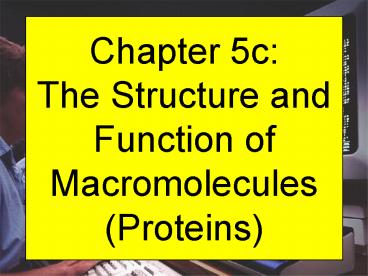Chapter 5c: The Structure and Function of Macromolecules (Proteins) - PowerPoint PPT Presentation
1 / 35
Title:
Chapter 5c: The Structure and Function of Macromolecules (Proteins)
Description:
Hydrophilic, reactive, two chiral carbons. Thr. T. Threonine. Hydrophilic, reactive. Ser ... Hydrophobic, two chiral carbons. Ile. I. Isoleucine. Hydrophobic ... – PowerPoint PPT presentation
Number of Views:139
Avg rating:3.0/5.0
Title: Chapter 5c: The Structure and Function of Macromolecules (Proteins)
1
Chapter 5cThe Structure andFunction
ofMacromolecules(Proteins)
2
Polymers, Monomers, and Lipids
polymer category of biomolecules monomer
polysaccharide carbohydrates monosaccharides
polypeptides proteins amino acids
polynucleic acids RNA DNA nucleotides
3
Protein Overview
- Major constituent of most cells (gt50 dry weight)
- Highly sophisticated molecules (or
multi-molecular complexes) - Extremely large number of unique proteins exist
- They are polymers folded into specific
conformations (shapes) - Conformation and functional-group chemistry
controls function - Made up of 20 different types of amino-acid
monomers - Proteins define what an organism is, what it
looks like, how it behaves, etc. (responsible for
most phenotype) - You are your proteins!
4
Protein Function
5
Globular versus Fibrous
Fibrous protein (e.g., collagen)
Just know general shapes
Globular protein (e.g., hemoglobin)
6
Enzymatic Catalysis
Globular protein
7
Monomer (amino acid) Structure
R group
8
Amino Acid Structure
The chemistry of R groups distinguishes amino
acids and their properties
9
Amino Acid Ionization
10
Amino Acid Types
Name R-Group Properties
Glycine G Gly Hydrophobic
Alanine A Ala Hydrophobic
Valine V Val Hydrophobic
Leucine L Leu Hydrophobic
Isoleucine I Ile Hydrophobic, two chiral carbons
Proline P Pro Cyclic, not terribly hydrophobic
Phenylalanine F Phe Hydrophobic, bulky
Tyrosine Y Tyr Less hydrophobic (than Phe), bulky
Tryptophan W Trp Hydrophobic, bulky (indole ring)
Cysteine C Cys Hydrophobic, highly reactive (S-S link)
Methionine M Met Hydrophobic (start a.a.)
Serine S Ser Hydrophilic, reactive
Threonine T Thr Hydrophilic, reactive, two chiral carbons
Lysine K Lys Highly hydrophilic, positively charged
Arginine R Arg Highly hydrophilic, positively charged
Histidine H His Highly hydrophilic, positive or neutral
Aspartate D Asp Highly hydrophilic, negatively charged
Glutamate E Glu Highly hydrophilic, negatively charged
Asparagine N Asn Uncharged
Glutamine Q Gln Uncharged
11
Non-Polar R groups
Know me!
12
Polar R groups
13
Five Categories
Note 20 (naturally translated) amino acids
14
The Peptide
No need to know side chain structures
Backbone -N-C-C-N-C-C-N-
Polypeptide linear chain of amino acids linked
by peptide bonds
15
Making the Peptide Bond
16
Limited Rotation
Explanation of double-bond character (resonance)
Be able to know which is the peptide bond
17
Backbone Rigidity
Because of Resonance the backbone of polypeptides
has greater rigidity than otherwise might be
expected
Polypeptide backbones are more than just wet
noodles!
18
Protein Depiction (4 ways)
Conformation Shape ? Function
The surface chemistry of a protein is determined
by the chemistry of exposed amino-acid R groups
The interior of proteins is held together by
R-group-to-R-group and backbone-to-backbone
interactions
19
ATP Synthase
This is what you use to make the bulk of your ATP
20
Pseudo 3D Image
21
Conformation Shape ? Function
22
Levels of Protein Structure
23
Protein Primary Structure
1 structure ordered sequence of amino acids
24
Protein Primary Structure
Note the Polarity of the sequence (amino ?
carboxy)
Note also the disulfide linkages (cys-cys ? S-S
bonds actually considered a component of
tertiary structure)
25
Protein Secondary Structure
Be able to recognize name these
Held together by interactions (H-bonds) between
peptide backbones
26
2 Structure H-Bonds
27
2 to Tertiary Structure
28
Protein Tertiary Structure
Tertiary structure is controlled by the
interactions between non-adjacent amino acid R
groups (note bond types)
29
Protein Quaternary Structure
Quaternary structure is the interaction between
adjacent polypeptides that make up a single
protein
Note that the polypeptides reside in discrete
subunits rather than being tangled together like
spaghetti
30
Protein Structure Overview
Polypeptide is not quite synonymous with
protein. The relationship is somewhat analogous
to that between a long strand of yarn and a
sweater of a particular size and shape that one
can knit from the yarn. A functional protein is
not just a polypeptide chain, but one or more
polypeptides precisely twisted, folded, and
coiled into a molecule of unique shape. It is the
amino-acid sequence of a polypeptide that
determines what three-dimensional conformation
the protein will take. (p. 70, Campbell et al.,
1999) (see p. 81 of 2005 edition)
31
Sickle-Cell Disease
32
Protein Denaturation
Destruction of Conformation Loss of Function
Some simple proteins can spontaneously renature
33
Protein Folding
A proteins specific conformation determines how
it works. In almost every case, the function of a
protein depends on its ability to recognize and
bind to some other molecule. p. 81, Campbell
Reece (2005)
34
Chaparonins
They segregate protein folding from bad
influences in the cell
Chaparonins Assist in Protein Folding
35
The End































